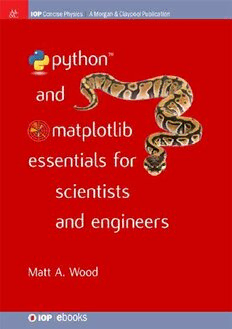
Python and Matplotlib Essentials for Scientists and Engineers PDF
Preview Python and Matplotlib Essentials for Scientists and Engineers
Python and Matplotlib Essentials for Scientists and Engineers Matt A Wood Department of Physics and Astronomy Texas A&M University-Commerce Morgan & Claypool Publishers Copyright © 2015 Morgan & Claypool Publishers All rights reserved. No part of this publication may be reproduced, stored in a retrieval system or transmitted in any form or by any means, electronic, mechanical, photocopying, recording or otherwise, without the prior permission of the publisher, or as expressly permitted by law or under terms agreed with the appropriate rights organization. Multiple copying is permitted in accordance with the terms of licences issued by the Copyright Licensing Agency, the Copyright Clearance Centre and other reproduction rights organisations. Rights & Permissions To obtain permission to re-use copyrighted material from Morgan & Claypool Publishers, please contact info@morganclaypool.com. ISBN 978-1-6270-5620-5 (ebook) ISBN 978-1-6270-5619-9 (print) ISBN 978-1-6270-5622-9 (mobi) DOI 10.1088/978-1-6270-5620-5 Version: 20150601 IOP Concise Physics ISSN 2053-2571 (online) ISSN 2054-7307 (print) A Morgan & Claypool publication as part of IOP Concise Physics Published by Morgan & Claypool Publishers, 40 Oak Drive, San Rafael, CA, 94903, USA IOP Publishing, Temple Circus, Temple Way, Bristol BS1 6HG, UK Contents Preface Acknowledgements About the author 1 Introduction: why Python and Matplotlib? 1.1 Numerical analysis and publication-quality plots 1.2 Enter Python 1.3 Resources 2 Downloading and installation 3 First steps 3.1 Working with strings 3.1.1 Hello, World! 3.1.2 Introduction to string methods 3.1.3 String concatenation 3.1.4 Slicing strings 3.1.5 Example: a sequence of file names 3.1.6 Error messages 3.2 Accessing user input 3.3 Your first Python program file 4 Working with numbers 4.1 A powerful calculator 4.2 Lists, tuples and arrays 4.2.1 Lists 4.2.2 Slicing lists 4.2.3 List comprehension 4.2.4 Tuples 4.2.5 Lists caution #1: copying lists 4.2.6 Lists caution #2: multiplying lists by a constant 5 NumPy arrays 5.1 Creating and reshaping arrays 5.1.1 NumPy 5.1.2 NumPy 5.1.3 Other array creation methods 5.2 Basic operations with arrays 5.2.1 Copying arrays 5.3 Dictionaries 5.4 Basic statistics 5.5 Universal functions 5.6 Precision and round-off error 5.7 NumPy matrix objects 6 File input and output 6.1 Reading from a file 6.1.1 General form: numbers and text 6.1.2 NumPy and 6.1.3 Reading and working with dates and times 6.1.4 Reading files with Astropy 6.2 Writing to a file 6.2.1 Formatted output 6.2.2 Writing text and numbers to a file 6.2.3 NumPy 6.2.4 Astropy 7 Simple programing: flow control 7.1 Conditionals 7.2 statements 7.3 loops 7.4 statements 7.5 and statements 8 Functions and modules 8.1 Introduction: coding best practices 8.2 Simple Python functions and modules 8.3 Functions with keyword arguments 8.4 Functional programming: list comprehension, and 8.4.1 Introduction 8.4.2 List comprehension and generator comprehension 8.4.3 The function 8.4.4 The function 8.4.5 The function 9 Classes and class methods 9.1 Introduction 9.2 Class attributes 9.3 Copying and deep copying 9.4 Methods 10 Making plots with Matplotlib 10.1 Simple line and point plots 10.2 Including error bars 10.3 Multiple plots on a page 10.4 Histogram plots 10.5 Quick and easy plotting routines for two-column data 10.6 Customization: text on plots, and inset figures 10.7 Image plots with 10.8 3D plots 10.8.1 3D scatter plots 10.8.2 3D wireframe and surface plots 11 Applications 11.1 Fits to data 11.1.1 Linear least squares: fitting a polynomial 11.1.2 Non-linear least squares 11.1.3 Linear systems of equations 11.2 Numerical integration 11.3 Integrating ordinary differential equations 11.4 Fourier transforms 11.5 Writing sound files 12 Visualization and animations 12.1 VPython 12.2 Making figures with Mayavi 12.3 Animations 13 Interfacing with other languages For Janie—with love. Preface Python and Matplotlib Essentials for Scientists and Engineers is intended to provide a starting point for scientists or engineers (or students of either discipline) who want to explore using Python and Matplotlib to work with data and/or simulations, and to make publication-quality plots. The active user base of Python and Matplotlib has been growing rapidly in recent years as people realize these packages have a very high level of functionality, are freely available for any likely operating system and are relatively simple to learn and use compared to similar software solutions. No previous programming experience is needed before beginning this book, as my aim is to make this a stand-alone introduction to Python and Matplotlib. Indeed, my hope is that you the reader can take this introduction and discover for yourself in just a few hours whether Python and Matplotlib provide most if not all of the tools you need to get your work done and your publication-quality plots rendered. The examples given in this book are available for download at the companion website pythonessentials.com. Acknowledgements I would like to thank first of all my wife Janie, for her encouragement and support. I am grateful to Pim Schellart of the Astrophysics Department of Radboud University, Nijmegen, The Netherlands, for first introducing me to the Python language, and to Martin D Still of the Science Mission Directorate at NASA for introducing me to more advanced Matplotlib capabilities and helping me to get up to speed. Finally, thank you to the students and SARA colleagues who have commented on earlier versions of this manuscript.
